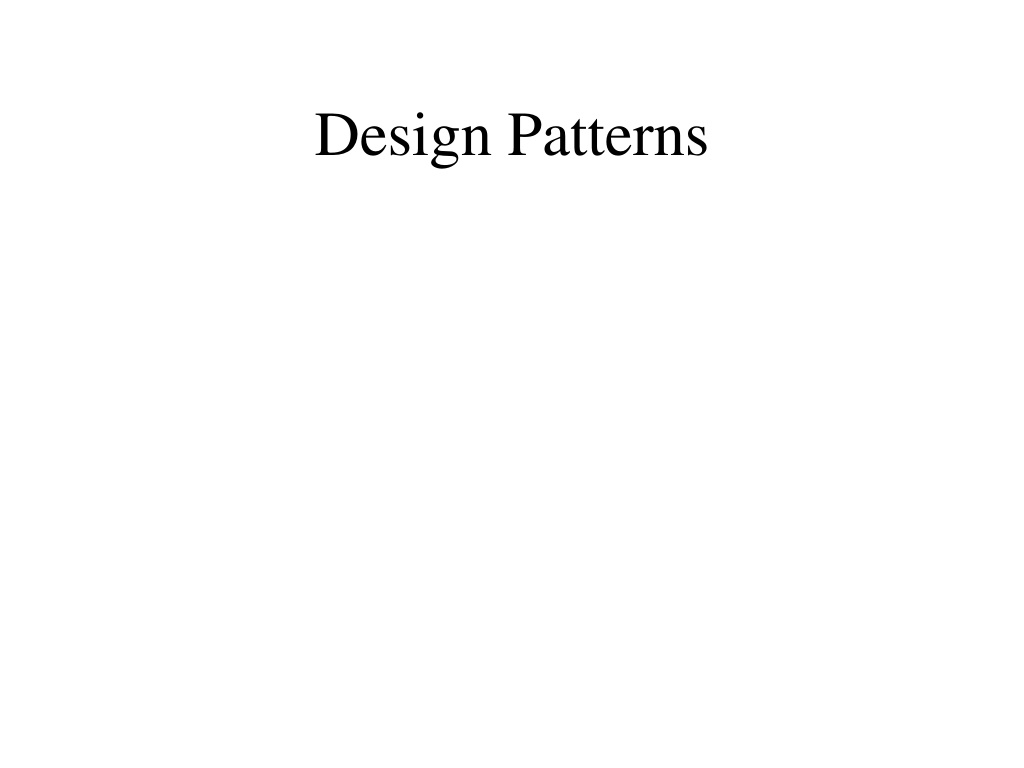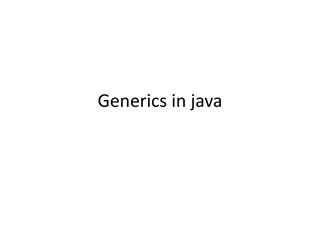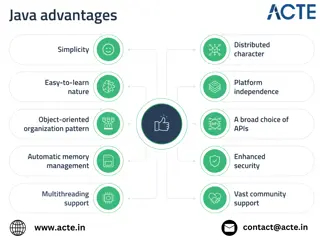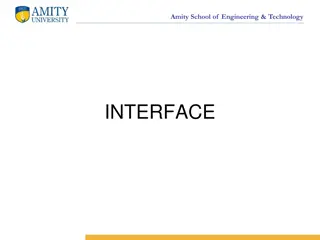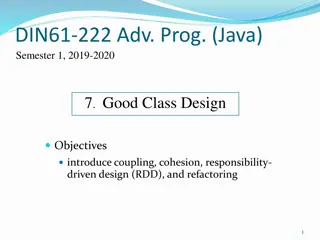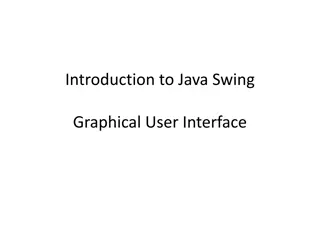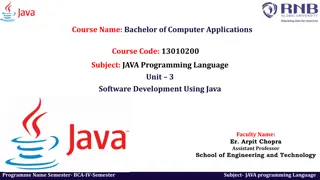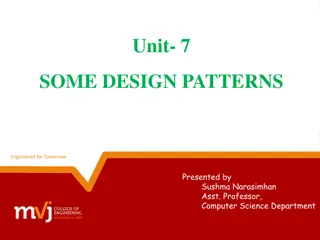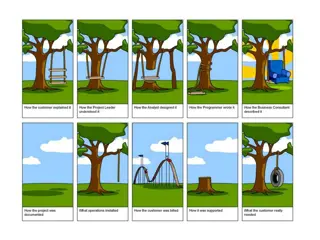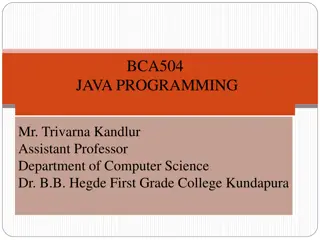Understanding Design Patterns in Java
Explore the world of design patterns with a focus on Java, covering key concepts such as creational, structural, and behavioral patterns. Learn about popular patterns like Singleton, Abstract Factory, Builder, and Prototype with practical examples and explanations.
Download Presentation

Please find below an Image/Link to download the presentation.
The content on the website is provided AS IS for your information and personal use only. It may not be sold, licensed, or shared on other websites without obtaining consent from the author. Download presentation by click this link. If you encounter any issues during the download, it is possible that the publisher has removed the file from their server.
E N D
Presentation Transcript
Thinking in Patterns with Java Bruce Eckel http://www.mindview.net/Books/TIPatterns/
Design Patterns Classification Creational Design Patterns Structural Design Patterns Behavioral Design Patterns
Creational Design Patterns Singleton Factory Method Factory Pattern Abstract Factory Builder Reusable Pool Prototype
Singleton Class Singleton { private static Singleton instance = null; private Singleton() {}; //private constructor public static synchronized Singleton getInstance() { if (instance == null) { instance = new Singleton(); } return instance; } }
Abstract Factory Pattern Specialised class just to create an instance of Product Client Factory Product <<abstract nebo interface>> <<abstract nebo interface>> ConcreteFactory ConcreteProduct public Product createProduct() createProduct() { return new ConcreteProduct(); }
Abstract Factory Pattern Window ClientClass <<abstract nebo interface>> WidgetFactory <<abstract nebo interface>> MotifWindow MetalWindow + createWindow() + createScrollBar() ScrollBar <<abstract nebo interface>> MotifScrollbar MetalScrollBar MotifFactory + createWindow() + createScrollBar() MetalFactory + createWindow() + createScrollBar()
Builder AbstractBuilder <<abstract or interface>> Director + builder + buildStep1() + buildStep2() + buildStep3() + getObject() + construct() construct() { builder.buidlStep1(); builder.buildStep2(); buidler.buildStep3(); getObject(); } ConcreteBuilder1 ConcreteBuilder2
Prototype AbstractPrototype <<abstract or interface>> use clone to instantiate Client + clone() ConcretePrototype1 ConcretePrototype2 clone() { // return copy of self } clone() { // return copy of self }
Prototype Shallow copy
Prototype Shallow copy copy
Prototype Deep copy
Prototype Deep copy copy copy
Reusable Pool + pool Client 0..* 1 1 ReusablePool <<singleton>> uses + acquireReusable(): Reusable + releaseReusable(): Reusable 1 * Reusable 0..*
Structural Design Patterns Adapter Bridge (sometimes considered to be a behavioral DP) Decorator Composite Facade Proxy and more
Adapter Vendor class Client class
Adapter Vendor class Adapter Client class
Adapter Vendor class Client class Adapter
Adapter Target <<interface>> Client request() Adapter Adaptee request() specificRequest()
The Dependency Inversion Principle High level modules should not depend upon low level modules; both should depend on abstractions. Abstractions should not depend upon details; details should depend upon abstractions.
Dependency Inversion Principle Dependency inversion principle specific form of decoupling where conventional dependency relationships established from high-level are inverted (e.g. reversed) for the purpose of rendering high-level modules independent of the low-level module implementation details. The principle states: High-level modules should not depend on low-level modules. Both should depend on abstractions. Abstractions should not depend upon details. Details should depend upon abstractions. (From Wikipedia, the free encyclopedia)
The Dependency Inversion Principle Depends on
Bridge Jednoduch roz en p ede l ho diagramu design pattern Bridge
Bridge Depends on Does not depend on Depends on
Bridge Implementation M me v ce hledisek klasifikace. Pokud bychom je cht li zohlednit v jedn inheritan n hierarchii, do lo by k explozi po tu t d (pro r zn kombinace). e en odd lit klasifika n hlediska. Abstraction refinement
Bridge Bridge imp + drawLine(): void
Bridge imp.devDrawLine(); imp.devDrawLine(); imp.devDrawLine(); imp.devDrawLine(); Bridge imp + drawRect(): void DrawRect(); DrawText(); XDrawLine(); XDrawString();
Bridge AbstractProvider <<interface>> AbstractUser <<abstract or interface>> provider + oper1() + oper2() + operation() User1 User2 Provider2 Provider1 + operation() + operation() + oper1() + oper2() + oper1() + oper2() operation() { provider.oper1(); } operation() { provider.oper2(); }
Bridge 1. The Bridge pattern is intended to keep the interface to your client class constant while allowing you to change the actual kind of class you use. 2. You can extend the implementation class and the bridge class separately, and usually without much interaction with each other (avoiding permanent binding between abstraction and its implementation). 3. You can hide implementation details from the client class much more easily.
Decorator InputStream ObjectInputStream ObjectBufferedInputStream BufferedInputStream Possible class explosion (hard to maintain) Decorator patterns helps ...
The Open-Close Design Principle Software entities like classes, modules and functions should be open for extension but closed for modifications. Adding new functionality should involve minimal changes to existing code. => adding new functionality will not break the old functionality => old functionality need not be re-tested Most changes will be handled as new methods and new classes. Designs following this principle would result in resilient code which does not break on addition of new functionality.
Decorator (structural) InputStream
Decorator (structural) InputStream Buffered
Decorator (structural) Object S cukrem Buffered InputStream K va
Decorator (structural) Component << abstract >> 1 ClientClass methodA() methodB() // other methods Decorator << abstract >> ConcreteComponent 0..1 methodA() methodB() // other methods methodA() methodB() // other methods ConcreteDecoratorA ConcreteDecoratorB methodA() methodB() // other methods methodA() methodB() // other methods
Decorator (structural) Component << abstract >> 1 ClientClass methodA() methodB() // other methods Decorator << abstract >> ConcreteComponent 0..1 methodA() methodB() // other methods methodA() methodB() // other methods Object ConcreteDecoratorA ConcreteDecoratorB InputStream methodA() methodB() // other methods methodA() methodB() // other methods Buffered
Decorator (structural) InputStream is = new FileInputStream ("fff"); BufferedInputStream bis = new BufferedInputStream(is); ObjectInputStream ois = new ObjectInputStream(bis); BufferedInputStream bis = new BufferedInputStream(new FileInputStream("fff"));
Decorator (structural) The Decorator Pattern attaches additional functionalities to an object dynamically. Decorators provide a flexible alternative to subclassing for extending functionality. Decorator prevents explosion of (sub)classes.
Composite (structural) Abstract or interface graphic Returns Graphic
Composite (structural) graphic Forall g in graphic g.draw(); Add g to the graphic list
Composite (structural) uniformly regardless whether leaf or composite Views all components Default empty implementation Forwards the operation to all children
Faade (structural) Client Facade The fa ade provides a unified interface that is easier to use A B C D E F A complex subsystem
Faade (structural) The Fa ade Pattern provides a unified interface to a set of interfaces in a subsystem. Fa ade defines a higher-level interface that makes the system easier to use. Client Facade Design Principle Principle of least knowledge - talk only to your immediate friends. A B C D E F
Proxy (structural) request() request() Client Real Subject Proxy The Proxy Pattern provides a surrogate or placeholder for another object to access control to it.
Proxy (structural) request() request() Client Real Subject Proxy A remote object With Remote Proxy, the proxy act as a local representative for an object that lives in a different JVM.
Proxy (structural) request() request() Client Real Subject Proxy Virtual Proxy acts as a representative for an object that may be expensive to create. The virtual proxy often defers creation of the object until it is needed. After that, the virtual proxy delegates requests to the RealSubject.
Proxy (structural) <<interface>> Subject request() Proxy RealSubject subject request() request() The RealSubject does most of the work. The Proxy controls access to it. The Proxy often instantiates or handles creation of the RealSubject.
Flyweight (structural) Intrinsic state is stored in the ConcreteFlyweight object Extrinsic state is stored or computed by Client objects. Clients pass this state to the flyweight when they invoke they operations Clients should not instantiate ConcreteFlyweights directly. Clients must obtain ConcreteFlyweights from the FlyweightFactory to ensure they are shared properly. not all Flyweight objects need to be shared. It is common for UnsharedConcreteFlyweight objects to have ConcreteFlyweight objects as children.
